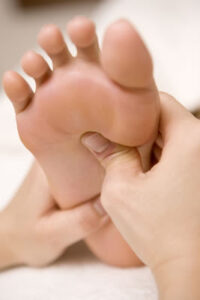Foot Surgery and Still Have Pain, Swelling, or Balance Concerns?
Facts about feet issues and surgeries
Bunions affect approximately 25-30% of adults.
Most common foot surgeries are to address:
- bunions
- hammer toes
- tendon release
- neuroma
- metatarsal repair
Feet still hurting after surgery?
 Your feet may have been hurting so bad that surgery seemed like the best solution.
Your feet may have been hurting so bad that surgery seemed like the best solution.
Surgery is finished, your foot is healed, and you likely did some physical therapy.
But …
- your feet don’t really feel right or still hurt,
- your ankles or feet are still swelling,
- shoes are uncomfortable, and/or
- your balance may seem wobbly.
Although the structure may be put back together, the feet and ankles have many relationships to the leg and core that may not yet be working well.
Your range of motion and strength are restored, yet there is so much more to put back together!
Feet move us, stop us, and keep us steady.
Feet and ankles absorb high levels of force when they strike the ground. These lesser known stabilizing and control relationships are integral to your comfort and security.
This ground related stress should be distributed through the entire skeletal system via well-functioning muscular interconnections at the joints. Well-rounded muscle coordination allows the body to both stabilize and attenuate force.
These muscle flows are often off-line or dis-jointed after foot and ankle injury or surgery. They need more specific guidance to function correctly again.
This is the heart of the Bridging® framework — how all the parts of the body connect and flow.
More to your full recovery …
At The Bridging® Institute we often meet people whose surgical recovery has been frustrating. The range of motion and strength are sufficient to graduate from rehab, but they just don’t feel right. In reality there is so much more to get you back to feeling ‘normal’.
Three more aspects to a complete recovery
Your complete return-to-function will benefit from:
- Restoring the multi-directional links from the foot and ankle to the knee, hip and core.
- Restoring the developmental layering which sustains the interconnection of the feet to the rest of the body.
- Clearing-up compensations when there was an injury, or immobilization after the surgery.
How do the feet interconnect with the rest of the body?
One of the most common relationships we find impacting people with foot and ankle recovery has to do with the ankle.
There is a paired function between the Achilles tendon and the muscles on the top of the ankle which is often disrupted by surgery, an injury, and the boot or cast used to immobilize afterward.
When this function works correctly, there is a reciprocal spring-like action at the ankle where muscles stretch and snap back. Kind of like the spring on the screen door. This is part of the spring in your step!
The secret to re-connecting the foot?
Uniquely, our approach goes back to early development as the secret to finding a well-rounded, long-lasting solution for your issues. Re-creating these layers of interconnections is the roadmap for sustainably solving your pain, swelling and balance issues.
Bridging® rebuilds the original movement foundation; your daily activity reinforces the better function.
Wondering if Bridging® can help your feet feel and function better? Fill out our intake form and we’ll get back to you with insights on how Bridging® can help.

